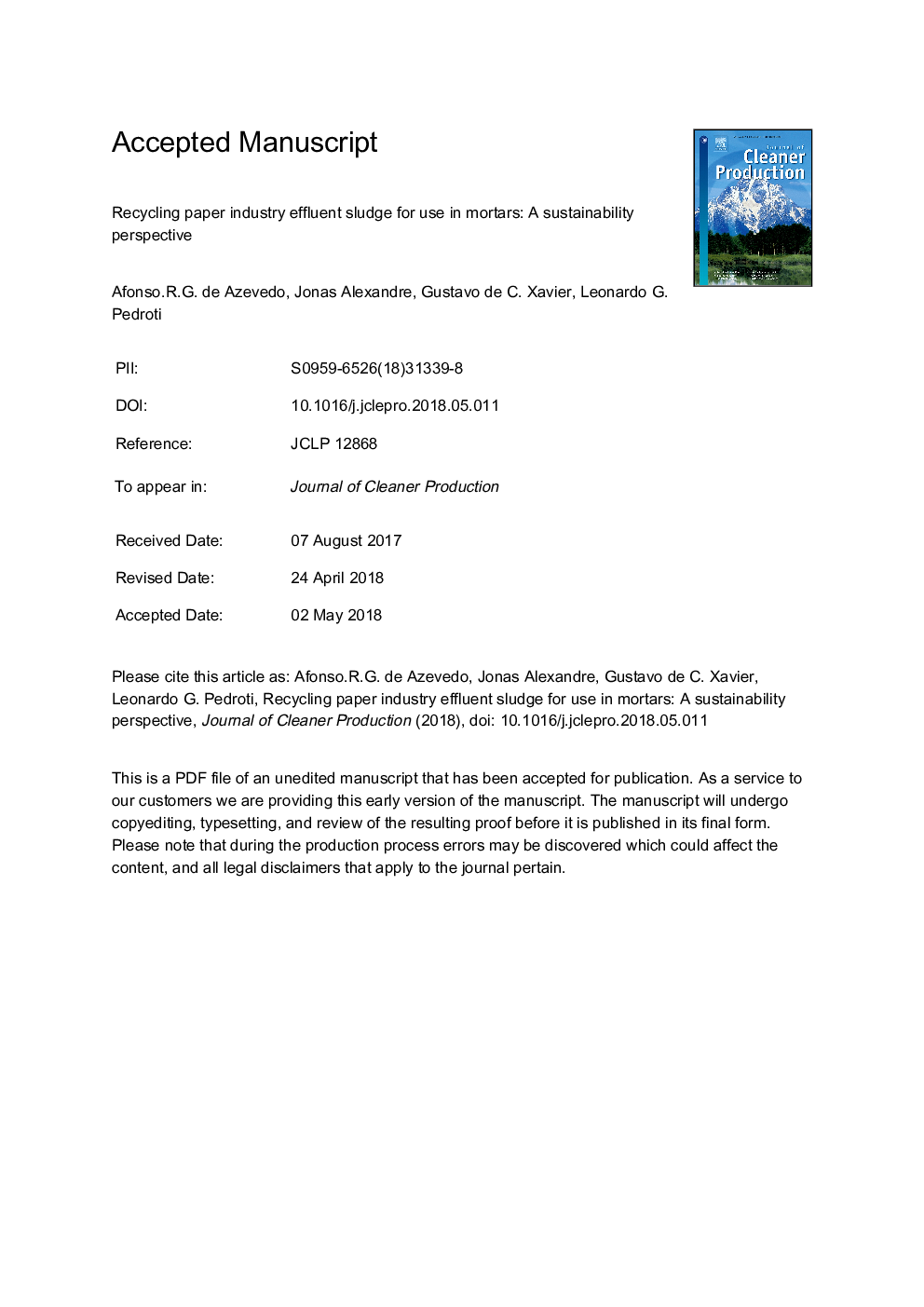| کد مقاله | کد نشریه | سال انتشار | مقاله انگلیسی | نسخه تمام متن |
|---|---|---|---|---|
| 8094553 | 1522061 | 2018 | 47 صفحه PDF | دانلود رایگان |
عنوان انگلیسی مقاله ISI
Recycling paper industry effluent sludge for use in mortars: A sustainability perspective
ترجمه فارسی عنوان
لجن فاضلاب صنعت کاغذ بازیافت برای استفاده در ملات: چشم انداز پایداری
دانلود مقاله + سفارش ترجمه
دانلود مقاله ISI انگلیسی
رایگان برای ایرانیان
کلمات کلیدی
زباله صنعتی، ملات، پایداری، لجن فاضلاب، صنعت کاغذ،
ترجمه چکیده
صنعت کاغذ و سلولز تولید مقادیر قابل توجهی از زباله ها، از جمله یک لجن بسیار مرطوب، که به عنوان یک فاضلاب با مسئولیت زیست محیطی بزرگ برای تولید کننده محسوب می شود. مطالعات نشان داده اند که این لجن زباله ممکن است در مصالح ساختمانی مانند ملات برای تثبیت بلوک، و همچنین برای سقف و پوشش دیوار استفاده شود که از سیمان سرامیکی به عنوان یک سیلانت استفاده می شود. بازیافت لجن دفع زباله و کاغذ صنعت دارای مزایای زیست محیطی مهم است، از طریق جلوگیری از آلودگی خاک و آب ناشی از دفع ناکافی و کاهش میزان تخریب منابع طبیعی مانند آهک مورد استفاده در مواد سیمانی. این تحقیق، پایداری ترکیب ضایعات این مواد را به ملات های مبتنی بر سیمان ارزیابی کرد. تست ها به جای جایگزین کردن آهک، یکی از گران ترین اجزای ملات با اثرات زیست محیطی بالا، با لجن های زباله در محتویات 5٪، 10٪، 15٪ و 20٪ انجام شد. پس از آن تجزیه و تحلیل بر روی نمونه ها برای ارزیابی ویژگی های فنی اولیه این خمپاره های متشکل از شاخص انسجام، گرمای هیدراتاسیون، محتوای هوای مجزا، احتباس آب، مقاومت مکانیکی و ضریب کاپیتاریا انجام شد. نتایج با نتایج آزمایشات مشخصه ای که بر روی مواد زائد انجام شده مقایسه شدند. نتایج نشان می دهد که برای استفاده در پوشش های ملات دیوار و سقف، سطح پیوستگی نباید بیش از 10٪ باشد، زیرا سطوح بالاتر مقاومت به مقاومت مکانیکی را پایین می آورد و ناسازگار با الزامات بازار است. این نتیجه احتمالا به دلیل گرمای کم هیدراتاسیون مواد زائد است که باعث ایجاد واکنش کندتر می شود. از سوی دیگر، مقادیر بالای مواد زائد، بالاتر از 10٪ مناسب برای ملات مورد استفاده برای پر کردن تعمیرات کوچک در سنگ تراشی است که نیازی به کنترل خواص ندارند.
موضوعات مرتبط
مهندسی و علوم پایه
مهندسی انرژی
انرژی های تجدید پذیر، توسعه پایدار و محیط زیست
چکیده انگلیسی
The paper and cellulose manufacturing industry generates significant quantities of waste, including an extremely humid sludge, which is considered to be an effluent with high environmental liability for the manufacturer. Studies have shown that this waste sludge may be utilized in construction material, such as mortar for fixing blocks, as well as for ceiling and wall coatings that use ceramic masonry as a sealant. The recycling of pulp and paper industry waste sludge has important environmental benefits, by preventing soil and water pollution caused by inadequate disposal and by reducing the depletion of natural resources, such as lime, used in cementitious materials. This study analyzed the sustainability of incorporating such waste into cement-based mortars. Tests were conducted replacing lime, one of the most expensive mortar components with high environmental impact, with waste sludge in contents of 5%, 10%, 15%, and 20%. Analysis was then performed on the samples to assess the primary technical characteristics of these incorporated mortars, such as the consistency index, heat of hydration, content of incorporated air, water retention, mechanical strength and the capillarity coefficient. The results were compared with the results of the characterization tests that were performed on the waste material. The results showed that for use in wall and ceiling mortar coatings, the level of incorporation should not exceed 10%, because higher levels yield lower values of mechanical strength resistance, incompatible with market requirements. This result is probably due to the low heat of hydration of the waste material which generates slower reactions. On the other hand, higher levels of waste material content, above 10%, are appropriate convenient for mortar used to fill small repairs in masonry that do not require control of properties.
ناشر
Database: Elsevier - ScienceDirect (ساینس دایرکت)
Journal: Journal of Cleaner Production - Volume 192, 10 August 2018, Pages 335-346
Journal: Journal of Cleaner Production - Volume 192, 10 August 2018, Pages 335-346
نویسندگان
Afonso R.G. de Azevedo, Jonas Alexandre, Gustavo de C. Xavier, Leonardo G. Pedroti,
